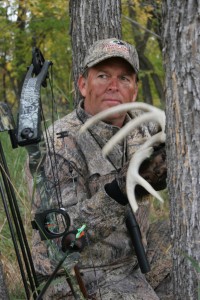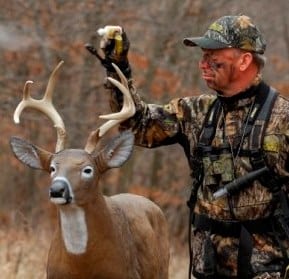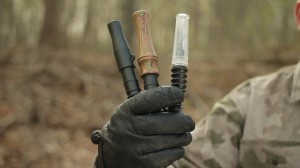 When November 10 rolls around in most states, you can pretty much throw your best-laid schemes out the window. Who knows when and where a muscle-bound, gnarly-racked buck drunk on testosterone is apt to show up dogging a doe in daylight hours? Throw in the hunting pressure you’ll likely have to deal with, and any grand big-buck plan you have will go south in a hurry.
When November 10 rolls around in most states, you can pretty much throw your best-laid schemes out the window. Who knows when and where a muscle-bound, gnarly-racked buck drunk on testosterone is apt to show up dogging a doe in daylight hours? Throw in the hunting pressure you’ll likely have to deal with, and any grand big-buck plan you have will go south in a hurry.
Here’s my theory. Instead of trying to implement a big, complex, tightly woven strategy, we ought to focus more on small, quick-strike tactics, like the 33 gems found here.
1) Don’t tell Joe down at the gun shop where you just saw a 10-pointer running a doe. And for heaven’s sake, don’t let him see where you go to hunt that buck. Sneak into your secret spot well before daylight, and wait until 11:00 a.m. or so to hike out, when old Joe and his cronies have left the woods for work. Protect your honey hole and you might drag a big deer out of there year after year.
2) If you were a horny buck which sound would you run to? The clatter of antlers, a grunt, or the meeaaa, meeaaa, meeaaa of a doe ready to mate? You won’t hear the estrus bleat very often (I’ve heard it only a handful of times) but it’s worth a shot in the peak of the rut. Try a can call; simply turn the can upside down to fill the woods with sexy bleats.
3) One morning you hear loud, deep-pitched gurgles in a thicket. Man, get ready! A buck has cornered a doe, and he’s talking to her with what I call “gargling grunts” (biologists call them tending grunts, but gargles sounder cooler). If the gal is not quite ready to stand and breed, she might soon bust out of the cover with the crazed boy on her heels. Shoot if you can.
4) In the rut I often hang out at the local watering hole. Not Molly’s Irish Pub, but a small, secluded pond or slough. When does and bucks run and chase, they get thirsty. While hunting over water is an obvious tactic for a hot, dry rut, try it during cold weather as well. “A few years ago in mid-November it was cold and all the waterholes in my area were frozen tight,” says whitetail expert Dan Perez. “One afternoon I busted a hole in a pond and climbed into my stand. Just before dark does and three good bucks trotted in for a sip.”
5) Is that $15 bottle of eau de doe you bought last October still steaming? If you didn’t open it, and if you stored it in a cool, dark place over the summer, it should be okay. But you probably carried the lure in your daypack and used it a few times. Chances are light, air and heat broke down and ammoniated the urine. Toss it and buy a fresh bottle.
6) Only a stud with a big rack and a neck like Mike Tyson’s can gouge, thrash or even snap in half trees four inches or larger in diameter. “Violent rubs” are the sign of not only a good buck, but also an aggressive buck, the kind you want to hunt. A brazen, dominant deer will prowl far and wide for does and with unbridled energy. Which means you have a pretty good chance of seeing him on his hooves in daylight hours.
7) “I once spotted a 140-class deer in a thicket, tending a doe and trying to run off two smaller bucks that wanted a piece of the action,” says celebrity hunter Mark Drury. “I picked up my rattling horns and clicked them lightly three times. The buck charged within 12 steps of my tree stand and stomped his foot. He winded me, but I was at full draw and took him. You don’t have to overdo it. Sometimes a few clicks or grunts are all it takes.”
8) One November morning I smoked an 8-pointer with my muzzleloader. His hocks were black as clumps of coal, and he reeked so badly I choked as I gutted. Pop, pop, pop in the leaves. I looked up and saw a 10-pointer boring down on me, eyes wild and tines held low! The intruder marched to within 20 yards; I feared an attack and all I had was an unloaded rifle. The buck stopped, studied the dead deer I crouched behind, detected no threat, and turned and walked away. It was my coolest hunt ever and it taught me something. Dominant bucks are drawn to the musk of one another late in the pre-rut. Play off that and set a mix of buck urine and tarsal near your stand. And be on your toes. A 200-pound buck homing in on the smell of an intruder is one bad dude.
9) Follow a rub line to a spot where it cuts a doe trail. There you should find a cluster of thrashed saplings, as well as a fresh scrape or two. Play the wind, hang a perch and look for the buck working the intersection.
10) When rattling or “grunting blind,” set up with the sun at your back and against thick cover. You’ll be hidden in the shadows—an incoming buck will be easy to see if sunlight hits his antlers or hide. Also, you need to trick a buck into thinking deer are fighting, tending or breeding in the brush 50 to 100 yards behind you. That forces him to keep looking, listening and moving…maybe into bow or gun range.
11) Crack horns the last few days of the pre-rut and into the peak, when bucks are stoked to come to the sounds of two rivals fighting for the favors of a doe. In my experience, rattling works best in the morning near a doe-bedding area or in a funnel that leads to it. A still, frosty dawn is perfect.
12) While you probably won’t rattle a big buck away from a hot doe you should still whack horns periodically throughout the peak and last throes of the breeding season. You might catch a good buck between does, and he might roll over to check out your ruckus.
13) It’s November 15 and the weather is perfect, overcast, calm and with temps in the low 30s. You hunt all day and see neither hide nor hair of a good buck. Well, it’s likely the big boys are holed up in thickets and having their way with does. Keep hunting your best stands back in the timber. In a day or two the bruisers will start cruising for new gals again.
14) In his book Way of the Whitetail noted whitetail photographer and researcher Leonard Lee Rue III wrote: “I have found that most deer breed about every four hours, and you can almost time it. As a doe is in estrus for 26 to 28 hours, the buck will breed her on the average of about six times.”
15) If you’re gonna bowhunt over a decoy, it ought to stink just right. Smear estrus lure on a doe, or hang a scent wick nearby. If you stick a plastic rack on your fake, smear buck urine or tarsal on its hind end. After setting an “intruder decoy” climb into a tree stand and grunt like a market hog every 30 minutes or so. A buck might stroll by, think your rank imposter is talking trash and saunter over to kick some booty.
16) One November afternoon Harold Knight, the call maker and deer-hunting legend from Kentucky, heard a fawn bleating forlornly. “The little deer must have bawled 50 times,” he says. “I figure a doe that was just about ready to breed had just kicked out the young ‘un. You don’t hear fawn bleating a lot, but listen for it. It can tell you the does are just about ready to come into heat.”
17) A grizzled 8- or 10-pointer is a night owl. He generally waits until after dark to go on the prowl for does, and he tends to stay up late into the wee hours. One morning the sun rises and the buck finds his big self a mile or more from his bedding area. As the deer sneaks frantically back for his sanctuary, you might get a crack at him from a stand on a ridge or in a funnel. That’s another reason I think mornings are best during the rut.
18) If you hunt in the East or South you can generally hunt a buck within 500 acres of a crop field where you spotted him back in September. Contrary to what many hunters believe, that holds for the big, open West as well. “In late summer I watch big bucks every day,” says Joe North, who hunts and guides along the Milk River in Montana. “If I spot a 160-class deer in an alfalfa field, he’s usually nosing around does within a half-mile or so come November. Even if a buck leaves a ranch for a couple of days, he’ll be back. Why hunt anywhere else?”
19) Find a swamp, clear-cut or other cover in heavy timber where does bed. When archery hunting, play the wind, move in tight and hang a tree stand in a fringe. Back 75 to 100 yards off the cover when using a muzzleloader or rifle. Hunt that stand enough and you will see bucks prowling around the gals.
20) Hang a gun stand on a ridge where you can cover two or more draws, ditches or creek drainages below. The thicker the cover on the ridge and in the funnels, the better. You’ll expect to see deer chasing down in the funnels and you sure might. Ah, but check around and behind you too. Bucks love to travel and bed in ridge thickets. You might be glassing 150 yards below when a big deer pops over the ridge and walks right into your lap.
21) Every year, from around November 6th to 20th in central, northern and western states, bucks have a ball, chasing down and breeding does. This season, when the orb waxes full the week of November 8, focus on the midmorning hours. Big deer that were up rutting all night in the yellow glow typically bed down at dawn, but some of them get back up and start prowling for does again between 9:00 11:00 a.m. Hang tough in a stand and you might whack the deer of your dreams during the “off hours.”
22) In my best Mr. T voice (remember him?) I bark, “Don’t set up on top of that scrape, fool!” It’s smarter to hang your tree stand 75 to 100 yards downwind of it, which reduces the chance that deer will see or smell you. When archery hunting set up within arrow range of a trail or thicket’s edge where a buck might prowl into the scrape from the downwind side. With a muzzleloader, slug gun or rifle simply set up where you can see far and bust a buck that cruises through the breeding commune.
23) Get out of that cool, shady draw or bottom where the wind swirls. Rather, set up on a hillside or ridge point, where the wind and thermals are steadier and more predictable. That’s good for a buck as he sniffs for does and tries to sort out their travels. It’s good for you as you try to cut his heated mission short.
24) Hoo-ah! The scent of a woman! Set some of that doe-in-heat on the upwind side of the doe trail you’re watching. You want the lure to blow down and across the path. If a buck comes along on the downwind side and likes what he smells, he might veer up to the trail and give you a shot.
25) Lay a long scent trail from your truck to your stand or blind and a no-so-funny thing might happen. A buck might cut your path, take a wrong turn and end up at your truck! Start out with boot pads soaked with fox or skunk scent to cover your tracks. Two hundred yards from your stand, remove those pads, tie on a drag rag doused with doe or buck lure and sneak the rest of the way in. Now if a buck cuts your trail he has only one way, the right way, to turn and go.
26) Biologists say the grunt-snort-wheeze is the most aggressive call in the whitetail’s vocabulary. A dominant buck doesn’t want other bucks around him or his does during the peak of the rut, so he grunts, snorts and pfftttfeeeezzzees at them. Try mixing snort-wheezes with grunts or rattles to challenge an alpha male and bring him in (M.A.D. makes a call for the job). The intimidating call can and will spook subdominant bucks.
27) Find scrapes every 50 yards or so and you’ll think you’ve hit the mother lode. But an immature buck feeling his oats might be doing all that excavating. Mature bucks tend to paw fewer, and larger, scrapes. Look for thick rubs and big tracks nearby; they seal the deal that you’re onto a good deer.
28) One day a 150-inch buck chased a doe past my perch. I grunted with my voice and the deer slammed on the brakes 22 yards away. Er, but amid all the excitement I forgot to draw my bow! When I tried to pull the buck jumped and bolted like he’d been poked with a prod. Keep your wits and remember to draw before you grunt, whistle or yell to stop a buck.
29) Tie a scent wick three to four feet off the ground and eye level to deer, rather than six feet up on a limb. If you set you scent too high, a buck might come in, tip back his nose to whiff it, look past the wick and see you moving or drawing your bow in your tree stand. Busted!
30) Everybody hunts the rut, so you’d better be ready to deal with the pressure. New York hunterDave Streb, who hunts national forest land in the Northeast, offers some tips. “Check topo maps and aerials for remote areas other guys might miss,” he says. “Drive around and monitor roads that have been locked for years. If the Forest Service opens a road this fall, few people might learn about it right away, and you can find good hunting back in there. The crowds subside with each passing day, so hunt deep into the second week of gun season if you can. Sit in a tree stand or blind all day. You never know when a buck will run by with a doe, or when some guy on the next ridge will scare a buck into your sights.”
31) Research a few years ago by Dr. Karl Miller, Larry Marchington and Matt Knox gives us some good skinny on rubs. The highly regarded biologists found that when an area is blazed with a noticeably large number of rubs, the peak of the rut often occurs earlier than normal. The theory is that by depositing gobs of “priming pheromones” on all those trees, the bucks stimulate the does into early estrus. So if you find twice or three times as many rubs as usual in your hunt zone this fall, you might want to take off work a week earlier than you normally do.
32) Say you’re stalking on the plains one day in November, and a doe jumps up in a grassy draw. Jog over to a tree and rest your rifle, or drop your shooting sticks and get ready. A shooter buck is apt to stand up anytime. If one does, don’t bang off a wild shot. As long as the buck keeps the doe in sight, he’ll stand there, tongue lolling and gawking. You should five or 10 good seconds at least to align your crosshair and drop him.
33) My calling locations have evolved over the years. I’ve started to set up less on big sign and more on the terrain and any visible structure in an area. I like to hang a stand where I can see a lot of country, like a big hardwood bottom or a wide hollow. When I see a buck on the prowl or dogging a doe, I try to pull him close with a few rattles, grunts or bleats.








